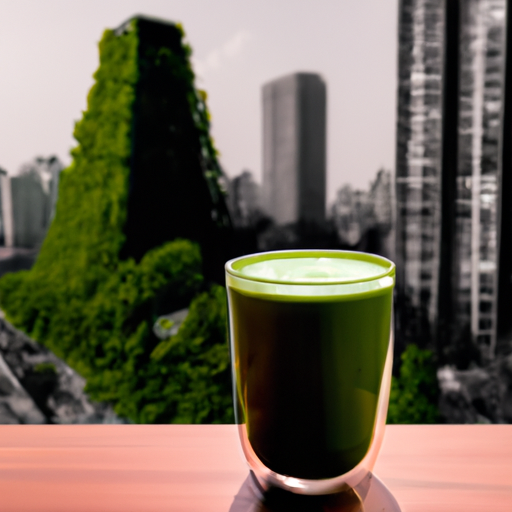Kicking off my day with a hot cup of turmeric tea is something I truly enjoy. It’s not just tasty; it’s also packed with health advantages. Turmeric is rich in curcumin, a component known for its anti-inflammatory and antioxidant characteristics.
Making homemade turmeric tea is incredibly easy and can be done in just a few simple steps. All you need are a few ingredients and some boiling water.
In this article, I will guide you through the process of making your own homemade turmeric tea so you can reap all the amazing health benefits while enjoying a tasty beverage.
Key Takeaways
- Homemade turmeric tea is easy to make with just a few ingredients such as turmeric powder, water, honey, and lemon slice.
- Boiling water is crucial for brewing turmeric tea and simmering the tea for 10-15 minutes allows all the flavors to meld together beautifully.
- Adding honey and lemon slices to turmeric tea can provide sweetness and additional health benefits due to their antioxidant and anti-inflammatory properties.
- Drinking turmeric tea every day can give important nutrients and antioxidants to the body, improve overall wellbeing, and help fight off inflammation while protecting against cellular damage.
Gather Your Ingredients
I love making homemade turmeric tea because it’s a delicious and healthy way to start my day. To make this tea, you’ll need some key ingredients like turmeric powder, water, honey, and a lemon slice (optional).
Turmeric is a powerful anti-inflammatory herb that can boost your immune system while also adding flavor to your tea.
Turmeric Powder
Mix the bright yellow turmeric powder into a pot of boiling water, creating a vibrant and aromatic base for your homemade turmeric tea. Turmeric powder is not only known for its distinct flavor and color but also for its numerous health benefits. This spice has long been used in cooking due to its anti-inflammatory properties that can help reduce the risk of certain chronic diseases such as heart disease, cancer, and Alzheimer’s disease. Additionally, it is packed with antioxidants that help protect your body against damage from free radicals.
Turmeric powder is not just limited to cooking; it can also be used in skincare routines. Its antibacterial properties make it an excellent natural remedy for acne-prone skin. The curcumin present in turmeric powder helps reduce inflammation and redness associated with acne, making it a great addition to face masks or spot treatments. With all these uses and benefits of turmeric powder, adding it to your daily routine through a warm cup of homemade turmeric tea is an easy way to reap its health benefits. Now let’s move on to the next step – water!
Water
Quench your thirst and rejuvenate your body with the most essential ingredient for our next step: water, the elixir of life that keeps us hydrated and healthy.
Drinking enough water is crucial for maintaining good health, as it helps regulate body temperature, aids digestion, flushes out toxins, and supports healthy skin. It’s recommended to drink at least 8 cups (64 ounces) of water a day to keep your body functioning optimally.
There are different types of water filtration systems available in the market that can help remove impurities from tap water. Some popular options include reverse osmosis systems, activated carbon filters, and distillation units. These systems can effectively remove contaminants like chlorine, lead, pesticides and herbicides from tap water.
However, it’s important to note that some minerals may also be removed during the filtration process which could affect the taste and nutritional value of the water. So choose wisely when selecting a filtration system for your home!
Now let’s move on to the next ingredient – honey!
Honey
Indulge in the sweet and natural goodness of honey, which adds a touch of golden sweetness to your morning oatmeal or drizzled over warm toast. But did you know that it can also be used as a natural sweetener in your homemade turmeric tea?
Instead of using processed sugars or artificial sweeteners, try adding a spoonful of honey for a healthier option. Not only does it add a delicious flavor, but honey also has numerous health benefits such as being rich in antioxidants and having antibacterial properties.
Using honey in other homemade teas is also a great way to enjoy its natural sweetness while reaping its health benefits. It’s an easy way to avoid added sugars and artificial flavors that are often found in store-bought drinks. Choosing natural sweeteners like honey can help reduce inflammation, improve digestion, and boost immunity.
So go ahead and add some sweetness to your life with this simple addition to your homemade turmeric tea recipe. Next up, let’s talk about adding a lemon slice (optional) for an extra burst of flavor!
Lemon Slice (Optional)
Enhance the refreshing taste of your turmeric beverage by adding a slice of tangy lemon, giving you a zesty kick to start your day. Adding lemon not only adds a burst of flavor but also provides numerous health benefits. Here are four reasons why adding a lemon slice to your turmeric tea is an excellent idea:
-
Lemon contains Vitamin C, which boosts the immune system and helps fight off infections.
-
The citric acid in lemons aids in digestion and can relieve bloating or constipation.
-
Drinking lemon water can improve skin health by reducing blemishes and promoting collagen production.
-
Lemons have anti-inflammatory properties that can reduce joint pain and inflammation.
To add a lemon slice to your turmeric tea, simply cut a fresh organic lemon into thin slices and add one to your teacup before pouring the hot water over it.
Now that you’ve added the perfect amount of zestiness to your turmeric beverage, it’s time to boil some water for brewing!
Boil the Water
To start the process, simply bring water to a boil in a pot or kettle. How to properly brew tea is crucial, and boiling water is no exception. Different types of tea leaves require different temperatures for optimal brewing, but for turmeric tea, it’s important to bring the water to a full boil. This not only extracts the flavor and benefits of turmeric but also helps increase its bioavailability.
Boiling water prepares the turmeric powder for brewing by releasing all its nutrients into the hot liquid. As you continue boiling, the mixture will become more concentrated and flavorful. Once your water has reached boiling point, reduce heat to low and let it simmer while adding one teaspoon of turmeric powder.
By now, you should have prepared your pot or kettle with boiling water and added your desired amount of turmeric powder.
As we move on to our next step – adding lemon slices – keep in mind that this ingredient is optional but can add an extra zestiness to your tea. So let’s dive in!
Add Turmeric Powder
Now it’s time for you to sprinkle a teaspoon of turmeric powder into your boiling water, allowing its rich flavor and health benefits to infuse into your tea.
Turmeric has been used for centuries in traditional medicine due to its anti-inflammatory properties and immune-boosting effects. By adding this spice to your tea, you’re not only giving it a vibrant yellow color but also enhancing its nutritional value.
Aside from making tea, there are different ways to use turmeric in cooking. You can add it to soups, stews, and curries for an extra punch of flavor and nutrition. Some people even make golden milk by mixing turmeric powder with warm milk and honey. The possibilities are endless when it comes to incorporating this superfood ingredient into your diet.
After adding the turmeric powder, let the mixture simmer for about 10 minutes before straining out the solids. This will allow all the flavors to blend together and create a delicious cup of homemade turmeric tea that’s packed with health benefits.
With just a few simple steps, you can enjoy a warm cup of goodness that not only tastes great but also supports your overall well-being.
Let It Simmer
As you wait for the tea to simmer, your anticipation grows for the delicious and nutritious cup of golden goodness that awaits. Simmering is a crucial step in making turmeric tea as it allows all the flavors to meld together beautifully.
To ensure that your tea simmers perfectly, use a low heat setting and let it cook for about 10-15 minutes. Make sure to keep an eye on the pot while simmering, and keep stirring occasionally to prevent any clumps from forming. Do not let the mixture boil vigorously as this can change the taste of the tea. If you want a stronger flavor, let it simmer for longer than 15 minutes. Experiment with different types of milk, such as almond or coconut milk, to create unique flavors.
Adding honey or maple syrup can help balance out bitter notes in turmeric. For a spicier kick, add ginger or black pepper. You can also add cinnamon or cardamom for a warm, comforting flavor.
As your tea simmers away on the stove, take some time to prepare your strainer and mug. With its vibrant color and intoxicating aroma, your homemade turmeric tea is sure to be a showstopper at any gathering.
Next up: strain the mixture into your favorite mug and enjoy!
Strain the Mixture
After simmering for 10-15 minutes, strain the golden mixture into a mug to reveal its vibrant color and intoxicating aroma. Using a strainer, pour the tea through and discard any remaining solids. This is important as turmeric can sometimes leave small clumps in the tea that can be unpleasant to drink.
If you prefer, you can drink without straining for added health benefits. However, if you find the texture unappealing, there are different ways to strain your tea. You may choose to use a cheesecloth or coffee filter instead of a traditional strainer. Alternatively, you could add other herbs such as ginger or cinnamon sticks when straining for an added flavor boost.
Straining also helps produce a smoother tea. Turmeric tends to have some grittiness that comes from using fresh ingredients rather than using dried powder form. Straining will help remove some of this texture and produce a much more enjoyable drinking experience overall.
With your mug full of beautifully colored turmeric tea in hand, it’s time to move on to adding honey and lemon slice for even more delicious flavor!
Add Honey and Lemon Slice
To take this turmeric drink to the next level, simply add a dollop of honey and a slice of fresh lemon – who can resist that sweet and tangy flavor combination? Honey not only adds sweetness but also has several health benefits. It’s rich in antioxidants, anti-inflammatory properties, and helps soothe sore throats. Adding honey to your turmeric tea can help boost immunity and aid digestion.
When it comes to choosing the right lemon slice for your turmeric tea, there are different types you can use. Meyer lemons are sweeter than regular lemons and have a more floral taste. Eureka lemons are tart with a bright acidic flavor that pairs well with the earthiness of turmeric. Whichever type you choose, make sure to wash them thoroughly before slicing them into thin rounds.
Once you’ve added honey and lemon slices, give your turmeric tea a good stir before enjoying it warm or chilled over ice. With these simple additions, you’ve elevated your homemade turmeric tea into a deliciously healthy beverage that’s perfect for any time of day!
Stir and Enjoy
Don’t forget to give your turmeric drink a good stir before savoring its deliciously healthy flavors. This step is important because it ensures that all the ingredients are well-blended and evenly distributed, resulting in a more satisfying taste experience.
As you stir, take note of the beautiful golden color of the tea, which is due to the natural pigment in turmeric called curcumin. Aside from being a tasty beverage, homemade turmeric tea also offers numerous health benefits.
Turmeric contains anti-inflammatory properties that can help alleviate joint pain and reduce inflammation in the body. It’s also rich in antioxidants that protect against free radicals and support overall cellular health. To further enhance these benefits, consider adding other spices like ginger or cinnamon for flavor variations.
By incorporating homemade turmeric tea into your daily routine, you can reap its many health benefits while enjoying its delicious taste. In the next section, we’ll explore some additional ways that this powerful spice can improve your overall wellbeing.
Health Benefits of Turmeric Tea
Drinking this golden elixir can pack a punch when it comes to boosting your health, as the spice contains properties that can help fight off inflammation and protect against cellular damage. If you’re looking for ways to incorporate turmeric into your diet, brewing a cup of homemade turmeric tea is an easy and delicious option. Not only does it taste great, but it also has numerous health benefits.
One of the main benefits of turmeric tea is its anti-inflammatory properties. Curcumin, the active ingredient in turmeric, has been shown to reduce inflammation in the body which can lead to a variety of health issues such as arthritis, heart disease, and cancer. In addition to this, turmeric also acts as an antioxidant which helps protect cells from damage caused by free radicals.
There are many different recipes for making turmeric tea at home, but one simple way is to brew hot water and add fresh or ground turmeric along with other spices like ginger or cinnamon. You can even add honey or lemon juice for added flavor. By drinking a cup of this delicious beverage every day, you’ll be doing your body a favor by giving it important nutrients and antioxidants that will help keep you healthy and feeling good.
Frequently Asked Questions
How much turmeric powder should I use per cup of tea?
When making turmeric tea, it’s important to use the right amount of turmeric powder for each cup. I typically use about 1/2 teaspoon of turmeric powder per cup of tea, but you can adjust this based on your personal taste preferences.
Turmeric tea is known for its many health benefits, including anti-inflammatory properties and improved digestion. It’s best to drink turmeric tea in the morning or before bed to help boost your energy levels and promote relaxation.
Overall, incorporating turmeric tea into your daily routine is a simple and effective way to support your overall health and wellbeing.
Can I use fresh turmeric root instead of turmeric powder?
Yes, you can definitely use fresh turmeric root instead of turmeric powder to make turmeric tea. In fact, using fresh turmeric root may have even more health benefits than using the powdered form as it contains higher levels of curcumin, which is the active ingredient in turmeric that has anti-inflammatory and antioxidant properties.
To use fresh turmeric root, simply peel and grate a small piece (about 1-2 inches) into a pot of boiling water along with any other desired ingredients such as ginger or honey. Let it steep for about 5-10 minutes before straining and enjoying.
Drinking this tea regularly can be beneficial for your skin as well due to its anti-inflammatory properties that may help reduce inflammation and acne.
How long should I let the tea simmer for?
Like a pot of soup on the stove, homemade turmeric tea needs time to simmer in order to develop its full flavor. The length of simmer time will depend on your desired tea strength and personal preference.
For a milder tea, I recommend letting it simmer for 10-15 minutes. However, if you prefer a stronger brew with more intense turmeric flavor and health benefits, let it simmer for at least 20-30 minutes.
Remember to keep an eye on the pot and adjust the heat as needed to prevent boiling or burning. With these simple steps, you can enjoy a delicious cup of homemade turmeric tea that’s both nourishing and satisfying.
What are some potential side effects of drinking turmeric tea?
When it comes to drinking turmeric tea, there are both potential risks and benefits to consider. On the positive side, turmeric contains compounds that’ve been linked to reduced inflammation and improved brain function.
However, if you consume too much turmeric, or if you have a sensitivity to this spice, you may experience side effects such as an upset stomach or even allergic reactions.
To minimize your risk of negative effects from drinking turmeric tea, be sure to use only small amounts of the spice at first and gradually increase your intake over time. Additionally, consult with your doctor before incorporating turmeric into your diet if you have any health concerns or are taking medications that could interact with this herb.
Can I store leftover turmeric tea and reheat it later?
Oh boy, I can’t wait to cozy up with a warm cup of turmeric tea tonight. But what if I make too much? Can I store it and reheat it later?
The answer is yes! Simply pour any leftover tea into an airtight container and store it in the refrigerator for up to 3 days. When you’re ready to enjoy it again, simply reheat on the stove or in the microwave until warm.
Remember not to boil the tea as this can destroy some of its health benefits. Now, back to making that delicious turmeric tea…
Conclusion
I hope this article has inspired you to make your own homemade turmeric tea. It’s a simple and delicious way to incorporate the health benefits of turmeric into your daily routine.
One objection you may have is that turmeric can have a bitter taste, but don’t let that deter you! Adding honey and lemon slices can help balance out any bitterness and create a tasty drink. Not only does this promote good health, but it also satisfies your taste buds.
So give it a try and enjoy the many benefits of this powerful spice in a warm cup of tea. Cheers to good health!










